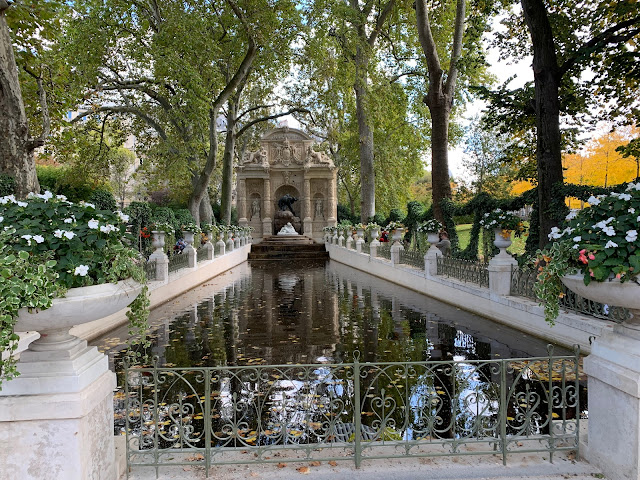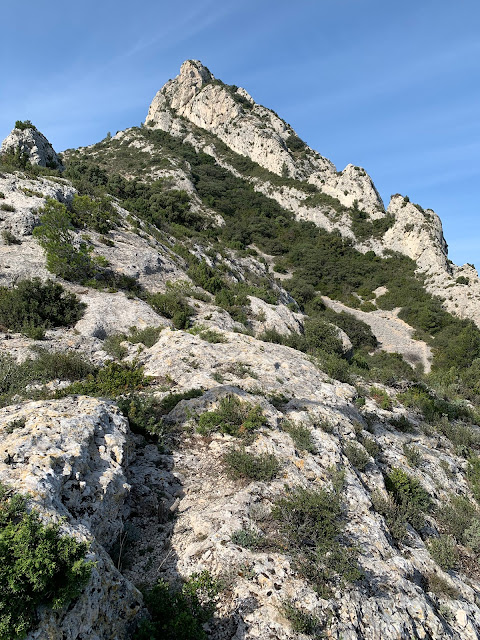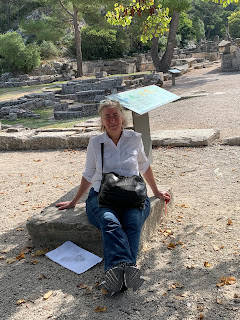 |
| (Moi? Non!) |
As I hadn't been in Paris for a really long time, it felt good to see the central city looking pretty much as it always has. Unlike London, where the tall and glossy new are sprinkled throughout the shorter and old, creative designs are often derided by the public with nicknames like the Shard, the Accordion, the Cheesegrater, the Prawn and the Gherkin. No pickles here, however!
When you climb high enough in Paris, the Pompidou Center for example, you can see those new tall buildings popping up here and there at the edges of central Paris. The only notable grouping of skyscrapers on the horizon is in Nanterre. From the Pompidou vantage point I saw this as a sort of front wall of Nanterre, because once you get to the other side of those tall buildings you will be in the old town of Nanterre, narrow streets and all. A surprise. I would not have been likely to find my way there if it hadn't been for staying briefly with my friend's cousin who lives there half the year (the other half in Palo Alto). But that visit was at the end of the trip. The first days were in the central first arrondissement.
 |
| The view from the café atop the Pompidou Center, Marais district. Nanterre's tall buildings loom in the distance. |
Paris was filled with sunshine while we were there, the cloudy day visit to the Marais on my last day. With a visit lasting only a few days, we decided to stay at a tiny hotel tucked into a small street behind the Louvre, as central as it was possible to be. Also, oddly, the area where all the chaffeurs in Paris seem to congregate while they wait for their riders. The Louvre was where we spent much of a second day, guided by my granddaughter Audrey who is in Paris for the semester, and topped off by terrific late afternoon food and drink on the Terasse at Café Marly.
 |
| The cute hotel |
The Louvre. So many people. So much art. So many galleries. And so many humongous paintings, created to memorialize great events real and/or imagined that needed to be hung in grand spaces. I was impressed, if that's the right word, by their enormity. The work below––not in the Louvre!–– is one I saw a week later in a gallery in St. Remy in Provence. It was only about 3 X 4 feet. Still, I felt it was related.
 |
| Flying bodies, not at the Louvre. |
After looking at so many of those giant paintings I felt as if I'd overeaten. It was a relief to see this old yet so modern work by the same painter of many of those other heroic epics, Jacques-Louis David.
 |
"The Death of Marat," actually a copy by the artist's studio,
the original in a Belgian museum. (Although David was from Brussels,
the subject of Marat is embedded in French history,
making for a sort of equality of ownership I suppose.) |
The work below wowed me, and how could it not: "The Hermaphrodite," an ancient Greek sculpture of a hermaphrodite body, amazing in itself, and placed on a mattress sculpted by Giovanni Bellini in 1620, several years after the discovery of the original sleeping figure in Rome. The mattess is so realistic I longed to sit on it, lie on it, caress it. As, I imagine, does everyone who sees it
 |
| With Audrey in the Napoleon Gallery |
Discordant notes. I couldn't make myself take photos of homeless people. This is the closest I allowed myself to get. Even that felt rude. There were many like this, too many, some people with tents but most without, especially in the most tourist-rich parts of the city. Most were immigrants. Immigrants were also hustling taxi rides, Eiffel tower models, or, more wretchedly, begging. Almosts everyone walked on by. Maybe they see the same people in the same places every day. It seemed far worse than in San Francisco. Maybe I'm wrong.
 |
| There's the tent. |
On main roads into the city there, especially around underpasses, there were makeshift encampments. There was also graffiti, the cartoon style favored in New York in the 1970's and 1980's. It was all over the railroad lines and many highways, even the occasional building in Provence. In some places nothing was immune from being tagged. I felt self-conscious photographing that, too.
 |
Graffiti like this shows up covering every bit of exposed surface along highways and rail lines. But
I saw none on historic buildings, and none on any variety of train car. But I can't say I looked everywhere. |
The Luxembourg Gardens was one of many other beautiful places in the city we walked around.
 |
| It's lights out in the City of Light at 11:45 to save energy. The Eiffel Tower lights go out with some fanfare. |
We headed to St. Remy de Provence in our neon orange Renault after a trip on the TGV to Avignon. I had never driven a Renault and so had no idea it shares eccentricities with the now-discontinued Saab, the only car I'd ever been unable to even start because it had an ignition located–unintuitively!–on the floor. For a manual shift car the Renault looked pretty standard, so we drove off, until a few kilometers from the rental office when it dawned on me that I probably would never be able to find my way into reverse. None of what I thought of as normal methods worked. The car would only move forward. Clearly, negotiating turns and parking are not simple matters when you can only move forward. Need I add, there was no operating manual in the car. With luck I managed turning around and we headed back to the lot. It's like this, the guy at the rental lot said irritably: you put your hand gently like so, and pull up the sleeve of the gear stick, and voilà! Yeah, voilà!
 |
| The car that wouldn't let me reverse. |
 |
| In St. Remy, a quiet street |
 |
Another street. Quiet here, but all the cafés are filled, and just around the bend...
|
Now able to drive like everyone else, we were able to explore the countryside around St. Remy. All we wanted to see was near at hand. (With the exception of parking in St. Remy itself, an issue that took about three days for us to suss out.)
If not wine growing, it will be olives––everywhere. Also very present are reminders of Van Gogh.
 |
| The Saint-Paul Asylum, a short drive from St. Remy, where Van Gogh was a self-admitted patient from May 1889 until May 1890, and made many of his most famous paintings. The field is planted with lavender. |
 |
| Van Gogh's room, as he may have left it. |
A distinctive geologic feature of the area around St. Remy is Les Alpilles mountain range, small in size, but dramatic in its protruding limestone peaks. Rising abruptly from the Rhone Valley it is only 15 miles long and a mere six miles wide. The highest peak reaches only about 1,600 feet, making hiking to the heights an easy matter. (For comparison, Buck Mountain near my house in Vermont is some 1,400 feet tall, not nearly so dramatic a mountain but with a spectacular view.)
 |
The trail to the highest (?) peak of Les Alpilles
|
Having reached this ridge I was met by a sign that read, translated, "Big Game Hunting in Progress, Watch Out for Bullets." I didn't see any bullets flying through the air, and given the small size of the area being hunted, I wondered how many wild animals––deer? boar?––might be here to be shot. Nevertheless, with my co-traveler Susan waiting below, I turned around.
Then there was Glanum, a once-wealthy Roman city a short walk outside St. Remy. Where I had expected to find only traces of early Romans, perhaps a column or two, the size and scope of this site this amazed me.
Glanum was originally settled by a Celtic-Ligurian tribe in the 4th century BCE and built around the source of a spring that it was believed had healing properties. The spring became a shrine to Glanis, a Celtic god. The spring is still intact, and had been protected and honored by a temple the Romans built over it. The early settlement was heavily influenced by contact with the Greek colony of Massalia (today's Marseille). Glanum became a Roman town after its capture by Julius Caesar in 49 BCE, and remained a wealthy and impressive town until 260 CE when it was destroyed by the Alamanni, a confederation of Germanic tribes, after which it was abandoned. With its drains and sewers lacking maintenance as it sat derelict, the ruins eventually flooded and became covered with mud and silt, offering a kind of natural protection. This didn't prevent the removal of many stones, however, that were used to build St. Remy. The site wasn't excavated until 1921.


 |
| As the temple ruin (above) looked when first built. |
 |
Mausoleum and triumphal arch right outside Glanum center, dates to around
40 BCE and some time before 14 CE, respectively.
|
 |
| Ancient writing has such immediacy, like a note written to the present. |
 |
| The sacred spring. The gold spot below is a carp. |
 |
| If you were to look at this photo from a different angle, putting the rectangular pit in the center... |
 |
| ...you might recognize the rectangular pool (#2) and the columns behind it in this drawing of a drainage system. The top pool collects rainwater which overflows into a tank (#3) that in turn flows out (#4) to clean the latrines (#5, beyond the drawing). The #6 refers to addition of columns by Romans to what was originally a Greek house. |
It's also about the food, of course. I wanted to bring all of it back home. But alas. Here I find myself once again at the Processed Food Store for basics, and then do my best to find stuff that resembles the stuff pictured below. Where else have I ever seen gorgonzola dished out like ice cream? (See the scoop in hand in the fifth photo below.)
 |
| In a tiny cheese shop, Provence. |
 |
| Champagne at prices I'll likely never see here. |
 |
| At the Sunday market, Nanterre |
 |
At the Wednesday market in St. Remy
|
 |
Coming home from the Sunday market in the old section of Nanterre. Here there were no visible
homeless or beggars. Immigrants here seem to have found what those in the central city have not. |
Speaking of food, restaurant menus in St. Remy de Provence had much similarity to one another, but surprisingly, although plenty of fish was sold in the market, it didn't make it to many menus, despite the relatively short distance from St. Remy to the Mediterranean. This menu from Gus Restaurant there was untypical as they offered seafood. Plus the best oysters! (The Ostra Regal.)*
 |
| The oysters, the Ostra Régal, were among the best I've ever tasted. |
The most charming town was Eygalieres, a hilltop town we stumbled upon the day we hiked in the Alpilles. And where I enjoyed the best lunch of canard foie gras, a savory crème brûlée and onion chutney with local white wine in a lovely café on a beautiful day. Here in Eygalieres we ran across Vermont Bicycle Tours–again. We had already seen their support van twice in St. Remy.
 |
| The tables were packed minutes before. |
 |
| View from the top of Egalieres, looking back at Les Alpilles |
It was a good time.
*Here’s what I read about later re those terrific oysters:
“Grown by La Famille Boutrais, of French oyster fame, this is the cadillac of the Boutrais oysters, but–c’est un scandale!–it’s actually an Irish oyster, confirming the worst-kept secret of French oysters: Ireland has the terroir superieure! (All Boutrais oysters are Irish, actually.) Seed is grown in Clew Bay, on the west coast of Ireland, for a year, until the oysters are about an inch and a half, and then the rock stars (less than 5% of the candidates) are transferred to Bannow Cove for two more years to complete their transformation into, well, rock stars. Only the heaviest, roundest, curviest oysters are used. They are given lots of space–just two oysters per square meter–so they can feast on the rich springs that feed the bay, which has a very narrow opening to the sea, allowing it to fucntion like a giant natural claire. By the time they come to market, they are four years old and filled with dense, sweet, mineral meats."










































